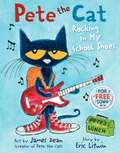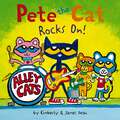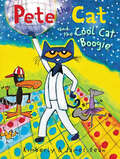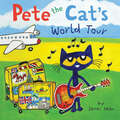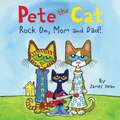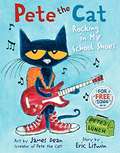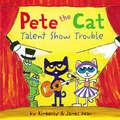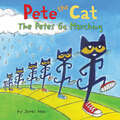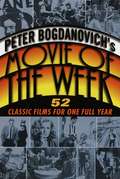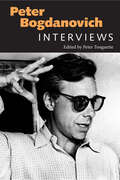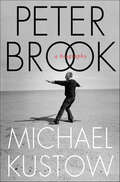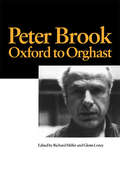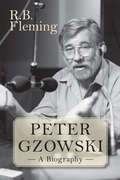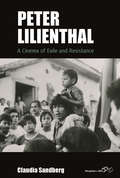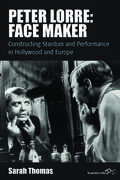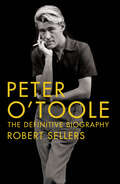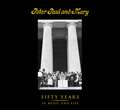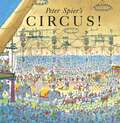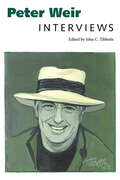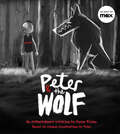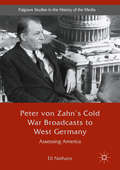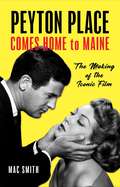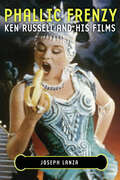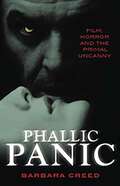- Table View
- List View
Pete the Cat Rocking in My School Shoes: A Back To School Book For Kids (Pete The Cat Ser.)
by Eric LitwinPete the cat wears his school shoes while visiting the library, the lunchroom, the playground, and more while singing his special song.
Pete the Cat Rocks On! (Pete the Cat)
by Kimberly Dean James DeanRock on with Pete the Cat in this groovy storybook about keeping calm and rocking on by New York Times bestselling author-illustrator team Kimberly and James Dean. Includes over thirty stickers!Pete the Cat can’t wait to rock out at the Alley Cats concert! But when the band never comes onstage, it’s up to Pete to find them. Will Pete have the right instruments to help the Alley Cats save the show? Find out in this rockin’ story full of problem-solving and friendship! Includes over thirty awesome stickers.
Pete the Cat and the Cool Cat Boogie (Pete the Cat)
by Kimberly Dean James DeanPut on your dancing shoes—Pete is ready to boogie!Pete is learning a new dance—the Cool Cat Boogie! When he hears a groovy beat, he’s full of happy in his feet. But when Grumpy Toad tells him, “Pete, you dance all wrong!” Pete is determined to become a better dancer.With the help of his friends and some wise words from Owl, Pete learns that he’s his grooviest when he’s being himself. Includes step-by-step dance moves so readers can dance along with Pete!Join Pete the Cat in this groovy story from New York Times bestselling author-illustrator team James and Kimberly Dean! Don't miss Pete's other adventures, including Pete the Cat: I Love My White Shoes, Pete the Cat: Rocking in My School Shoes, Pete the Cat and His Four Groovy Buttons, Pete the Cat Saves Christmas, Pete the Cat and His Magic Sunglasses, Pete the Cat and the Bedtime Blues, Pete the Cat and the New Guy, Pete the Cat and the Missing Cupcakes, Pete the Cat and the Perfect Pizza Party, and Pete the Cat: Crayons Rock!
Pete the Cat's World Tour (Pete the Cat)
by Kimberly Dean James DeanDon't forget your passport...it's Pete the Cat's groovy tour around the world! In Pete the Cat's World Tour, from New York Times bestselling author and illustrator James Dean, Pete the Cat and his band have packed up their bags and are ready to perform all over the globe. But what’s the fun in globe-trotting if you don’t go out exploring?From Mexico to Iceland, Pete and his friends get a taste of what each country has to offer.
Pete the Cat: Rock On, Mom and Dad! (Pete the Cat)
by Kimberly Dean James DeanRock out with Pete the Cat in New York Times bestselling artist James Dean's Pete the Cat: Rock On, Mom and Dad!Mom and Dad do so much for Pete that he wants to thank them with a special surprise. But what can Pete do that will show Mom and Dad how much he loves them?In this groovy story, Pete learns that it’s not what you do but how you do it that matters, so long as it comes from the heart. Young readers will love watching Pete surprise Mom and Dad with something totally awesome.Moms and dads looking for a Mother's Day or Father's Day present for their child to give should consider Rock On, Mom and Dad!
Pete the Cat: Rocking in my School Shoes (Into Reading, Big Book Module 1)
by Eric Litwin James DeanNIMAC-sourced textbook <P><P>Time to head back to school with this bestselling groovy Pete the Cat book! <P><P>Pete the Cat is rocking in his school shoes. Pete discovers the library, the lunch room, the playground, and lots of other cool places at school. And no matter where he goes, Pete never stops moving and grooving and singing his song...because it’s all good. <P><P>The fun never stops—download the free groovin’ song. <P><P>Lexile Measure: AD430L
Pete the Cat: Talent Show Trouble (Pete the Cat)
by Kimberly Dean James DeanRock out with Pete the Cat and Grumpy Toad in this brand-new book from New York Times bestselling author-illustrator team Kimberly and James Dean. Includes over 30 cool stickers!Pete the Cat’s school is hosting a fun talent show! Pete knows just what to sign up for—playing the guitar. But when he writes his name on the list, he is surprised to see Grumpy Toad also signed up for the same talent.Join Pete the Cat and Grumpy Toad as they learn about the importance of teamwork and friendship!
Pete the Cat: The Petes Go Marching (Pete the Cat)
by Kimberly Dean James Dean#1 New York Times bestseller James Dean puts a groovy spin to the classic children’s song “The Ants Go Marching" with everyone's favorite cool cat. Join Pete the Cat as he rocks out to this classic tune with a supercool twist in this paper-over-board picture book.Your child, or even your classroom of children, is sure to want to march along with Pete, 1, 2, 3!
Peter Bogdanovich's Movie of the Week: 52 Classic Films for One Full Year
by Peter BogdanovichA FRONT-ROW SEAT TO A YEAR'S WORTH OF MUST-SEE FILMSDirector, producer, screenwriter, author, actor, and film critic, Peter Bogdanovich knows movies. Now, in this unique new book, he shares his passion with a connoisseur's insight and delight by inviting the reader to join him for a year at the movies--fifty-two weeks, fifty-two films, fifty-two reasons to watch. Which films does Peter Bogdanovich call . . ."The most hauntingly chilling, strangely prophetic science-fiction picture ever made."(You'll be treated to it on Halloween)"A scintillatingly directed comedy."(Discover it with someone you love on Valentine's Day)"A bittersweet human comedy of vintage genius [that] only becomes more precious as the years pass."(Ringing in the New Year with it is reason enough to celebrate)With recommendations specific to the seasons and holidays--from sparkling comedies, timeless musicals, landmark foreign films, powerful dramas and thrillers to legendary masterpieces and neglected treasures--Bogdanovich's eclectic cinematic calendar of classics, each available on video, each accompanied by an illuminating essay, and each followed by a list of tie-in recommendations, makes the perfect date for movielovers every week of the year.From the Trade Paperback edition.
Peter Bogdanovich: Interviews (Conversations with Filmmakers Series)
by Peter TonguetteBefore he was the Academy Award-nominated director of The Last Picture Show, Peter Bogdanovich (1939–2022) interviewed some of cinema's great masters: Orson Welles, Alfred Hitchcock, John Ford, and others. After becoming an acclaimed filmmaker himself, he gave countless interviews to the press about his own career. This volume collects thirteen of his best, most comprehensive, and most insightful interviews, many long out of print and several never before published in their entirety. They cover more than forty years of directing, with Bogdanovich talking candidly about his great triumphs, such as The Last Picture Show and What's Up, Doc?, and his overlooked gems, such as Daisy Miller and They All Laughed. Assembled by acclaimed critic Peter Tonguette, also author of a critical biography of Bogdanovich, these interviews demonstrate that Bogdanovich was not only one of America's finest filmmakers, but also one of its most eloquent when discussing film and his own remarkable movies.
Peter Brook: A Biography
by Michael KustowPeter Brook is one of the world's legendary theater directors. His productions are a byword for imagination, energy, and innovation. From his ground-breaking production of Marat/Sade, to his "white box" A Midsummer Night's Dream, to his monumental staging of The Mahabharata and beyond, Brook has always been the pioneer of what a director and a company of actors can conjure out of an empty stage. In this first authoritative biography, arising out of an association and friendship with Brook over forty years, Michael Kustow tells the fascinating and revealing story of a man whose life has been a never-ending quest.Born into a Russian émigré family in London, Brook has been fascinated by theater and film since childhood. He studied at Oxford, where he made a film of Laurence Sterne's A Sentimental Journey and was almost sent down during his turbulent undergraduate years. As a brilliant young man influenced by the theatrical visionary Gordon Craig, he turned his hand to Shakespeare, opera, new French drama, and mainstream comedy. Following Craig's philosophy, Brook began to search for a simplicity, harmony, and beauty that would incorporate all aspects of the stage production under the control of one person. He also began the lifelong search for authenticity on the stage, a search that led him around the world from London to New York, to his legendary Théâtre des Bouffes du Nord in Paris, to Broadway and the Brooklyn Academy of Music. It was in Paris, in the 1970s, that he attempted to discover a universal language of theater with an international group of actors. This collaboration resulted in a series of visually spectacular and innovative shows including The Ik,The Conference of the Birds, and The Mahabharata.In his long and influential career, he worked with some of the world's greatest actors and writers including Glenda Jackson, Paul Scofield, John Gielgud, Laurence Olivier, Irene Worth, Jeanne Moreau, Peter Weiss, and Truman Capote. His films, such as Lord of the Flies,Moderato Cantabile, King Lear (with Paul Scofield), The Beggar's Opera, and the film of Marat/Sade moved the camera and the screen to borders they had not reached before. His book The Empty Space continues to be one of the classic works on theater and drama in the Western canon and his memoir, Threads of Time, gave us a glimpse into his personal development. In this biography, based on extensive interviews with Peter Brook and many of the actors, writers, producers, and directors he's worked with throughout his life, Michael Kustow goes to the heart of Brook's theater, his self-searching and his unceasing desire to produce work that redefines theater and life.
Peter Brook: Oxford To Orghast To India
by R. Helfer G. LoneyPeter Brook is known internationally as a theatre visionary, and a daring experimenter on the cutting-edge of performance and production. This book concentrates on Brook's early years, and his innovative achievements in opera, television, film, and the theatre. His productions are viewed separately, in chronological order, suggesting Brook's developing and changing interests. The authors include thought-provoking interviews with Brook (and with numerous outstanding artists who have worked with him) and bring to the reader penetrating critiques of Brook's theories and practices as a man of the theatre.
Peter Gzowski: A Biography
by R. B. FlemingBorn in 1934, Peter Gzowski covered most of the last half of the century as a journalist and interviewer. This biography, the most comprehensive and definitive yet published, is also a portrait of Canada during those decades, beginning with Gzowski’s days at the University of Toronto’s The Varsity in the mid 1950s, through his years as the youngest-ever managing editor of Maclean’s in the 1960s and his tremendous success on CBC’s Morningside in the 1980s and 1990s, and ending with his stint as a Globe and Mail columnist at the dawn of the 21st century and his death in January 2002. Gzowski saw eight Canadian Prime Ministers in office, most of whom he interviewed, and witnessed everything from the Quiet Revolution in Qubec to the growth of economic nationalism in Canada’s West. From the rise of state medicine to the decline of the patriarchy, Peter was there to comment, to resist, and to participate. Here was a man who was proud to call himself Canadian and who made millions of other Canadians realize that Canada was, in what he claimed was a Canadian expression, not a bad place to live.
Peter Lilienthal: A Cinema of Exile and Resistance (Film Europa #25)
by Claudia SandbergBest known for his 1979 film David, Peter Lilienthal was an unusual figure within postwar filmmaking circles. A child refugee from Nazi Germany who grew up in Uruguay, he was uniquely situated at the crossroads of German, Jewish, and Latin American cultures: while his work emerged from West German auteur filmmaking, his films bore the unmistakable imprints of Jewish thought and the militant character of New Latin American cinema. Peter Lilienthal is the first comprehensive study of Lilienthal’s life and career, highlighting the distinctively cross-cultural and transnational dimensions of his oeuvre, and exploring his role as an early exemplar of a more vibrant, inclusive European film culture.
Peter Lorre: Face Maker
by Sarah ThomasPeter Lorre described himself as merely a 'face maker'. His own negative attitude also characterizes traditional perspectives which position Lorre as a tragic figure within film history: the promising European artist reduced to a Hollywood gimmick, unable to escape the murderous image of his role in Fritz Lang's M. This book shows that the life of Peter Lorre cannot be reduced to a series of simplistic oppositions. It reveals that, despite the limitations of his macabre star image, Lorre's screen performances were highly ambitious, and the terms of his employment were rarely restrictive. Lorre's career was a complex negotiation between transnational identity, Hollywood filmmaking practices, the ownership of star images and the mechanics of screen performance.
Peter O'Toole: The Definitive Biography
by Robert SellersPeter O’Toole was supremely talented, a unique leading man and one of the most charismatic actors of his generation. Described by his friend Richard Burton as “the most original actor to come out of Britain since the war,” O’Toole was also unpredictable, with a dangerous edge he brought to his roles and to his real life.With the help of exclusive interviews with colleagues and close friends, Robert Sellers' Peter O’Toole: The Definitive Biography paints the first complete picture of this complex and much-loved man. The book reveals what drove him to extremes, why he drank to excess for many years and hated authority, but it also describes a man who was fiercely intelligent, with a great sense of humor and huge energy.Giving full weight to his extraordinary career, this is an insightful, funny, and moving tribute to an iconic actor who made a monumental contribution to theater and cinema.
Peter Paul and Mary: Fifty Years in Music and Life
by Peter Yarrow Noel Paul Stookey Mary TraversThis carefully crafted and collectible volume tells the intimate story of Peter, Paul, and Mary and their music, in their words and with iconic images that follow their passionate, fifty-year journey to the center of America&’s heart. Photographs, many rare and never before published, taken over five decades by some of the world&’s top photographers, follow them from their earliest performances in the 1960s, when Mary was the most desired, beautiful, and charismatic performer and a new role model for women. Follow the trio as they lead America to discover the passionate soul of folk music. Join the struggle for racial equality, social justice, and freedom in this memorable journey, from the historic 1963 March on Washington with Martin Luther King, Jr., to the trio&’s appearance before a half million people in 1969 to end the Vietnam War, to their singing at the Hollywood Bowl for Survival Sunday in 1978, helping to launch the anti-nuke movement, the world&’s first international environmental movement. Through these images, readers will feel and almost hear the trio&’s songs calling for a more caring, better world as they performed with a courage and conviction that became for so many the embodiment and soundtrack of their generation&’s awakening to conscience, to activism, and to a new dream for all of humankind. Peter, Paul, and Mary&’s songs of defiant hope and a certain unmasked innocence are still a powerful part of our American consciousness, and this book reenacts the history of how the trio marked many lives with their indelible stamp of honesty of the sort we all yearn to recapture and recreate today—for ourselves, our children, and the generations to come.
Peter Spier's Circus
by Peter SpierCome join the circus as Caldecott Medal-winner Peter Spier takes you for a look under the big top! The circus is coming to town! Take your front row seat to see how a circus runs—from setting up the tent to performing center ring. Go soaring through the air on the flying trapeze and see how performers from all over the world come together to put on a show. With showbiz excitement that only the circus can create—and Peter Spier's signature humorous details waiting to be discovered on every page—this book is a guaranteed ticket to fun and adventure.
Peter Weir: Interviews (Conversations with Filmmakers Series)
by John C. TibbettsPeter Weir: Interviews is the first volume of interviews to be published on the esteemed Australian director. Although Weir (b. 1944) has acquired a reputation of being guarded about his life and work, these interviews by archivists, journalists, historians, and colleagues reveal him to be a most amiable and forthcoming subject. He talks about “the precious desperation of the art, the madness, the willingness to experiment” in all his films; the adaptation process from novel to film, when he tells a scriptwriter, “I'm going to eat your script; it's going to be part of my blood!”; and his self-assessment as “merely a jester, with cap and bells, going from court to court.” He is encouraged, even provoked to tell his own story, from his childhood in a Sydney suburb in the 1950s, to his apprenticeship in the Australian television industry in the 1960s, his preparations to shoot his first features in the early 1970s, his international celebrity in Australia and Hollywood. An extensive new interview details his current plans for a new film. Interviews discuss Weir's diverse and impressive range of work—his earlier films Picnic at Hanging Rock, The Last Wave, Gallipoli, and The Year of Living Dangerously, as well as Academy Award-nominated Witness, Dead Poets Society, Green Card, The Truman Show, and Master and Commander. This book confirms that the trajectory of Weir's life and work parallels and embodies Australia's own quest to define and express a historical and cultural identity.
Peter and the Wolf: Wolves Come in Many Disguises
by Gavin FridayRelive the magic of Peter and the Wolf through this extraordinary modern retelling by award-winning musicians Gavin Friday and Bono. When a wolf is found roaming the woods, Peter&’s grandfather warns him to stay at home. But Peter, who is mourning the loss of a parent, decides to venture into the deep, dark woods in search of this creature…This incredible retelling of the well-loved classic story, Peter and the Wolf takes children aged 7-9 on an adventure while exploring themes of love and loss. With its spellbinding punk rock illustrations, this book is a beautiful reminder that there is hope after loss and those we love most are never truly gone. A timeless and magical gift book, Peter and the Wolf will be treasured by all. This modern retelling of Peter and the Wolf offers:- A dynamic new take on Prokofiev&’s tale about a young boy who captures a wolf, with magical graphic novel-esque illustrations.- An underlying theme of loss, told with sensitivity and warmth, helping children to understand and navigate the topic. - A treasured keepsake book based on a classic story beloved by generations of children and adults, with vivid illustrations and a red ribbon.- An enchanting story written by Gavin Friday and stunning visuals based on Bono&’s original illustrations - with an accompanying animated short film.In Prokofiev&’s original tale, Peter outsmarts the big, bad wolf, capturing him, and parading him victoriously around the town with the hunters. But this is not our ending and nothing is the way it seems…This extraordinary rendition of Peter and the Wolf echoes the message of courage that is so central to the famous classic, while gently introducing themes of loss, grief, and growing up and helping young readers to navigate them.
Peter von Zahn's Cold War Broadcasts to West Germany
by Eli NathansThis book examines the pioneering radio broadcasts and television documentaries about the United States made in the 1950s by the influential West German journalist Peter von Zahn. Part intellectual biography, part analysis of significant debates in West Germany, part study of an intensive encounter with the United States, the book helps explain the transformation of postwar West Germany. As a soldier in the Wehrmacht in World War II, Zahn held the militantly elitist views typical of young men in Germany's educated middle class. He reconsidered these positions in his postwar broadcasts. At the same time he coldly assessed the capacity of the United States to win the Cold War. His broadcasts examined McCarthyism, the African-American civil rights movement, and numerous aspects of American culture and politics. Zahn's broadcasts were one important voice in West German debates about the defects and virtues of modern democratic societies and especially of the United States, debates whose intensity reflected recent German experiences with the failure of the Weimar Republic and with Nazism. Zahn's analyses of the United States remain startlingly relevant today.
Peyton Place Comes Home to Maine: The Making of the Iconic Film
by Mac SmithIt is a well-known fact, perhaps legend now, that Peyton Place, the controversial, scandalous blockbuster was filmed in Camden, Maine and the surrounding towns in 1957. But how did the movie come to be filmed in Maine, who was involved in getting it here, and what did the locals think about 20th Century Fox shooting a big-budget film in their front yards?Historian Mac Smith (Mainers on the Titanic) has done the research and conducted the interviews and presents a fascinating account of events and key players. Beginning with the arrival of film crews, he traces the making of the movie, what happened after the crews left, and the premiere of the film, which was held in Camden.Includes quotes from Maine residents who were extras in the film.
Phallic Frenzy: Ken Russell and His Films
by Joseph LanzaA biography of director Ken Russell that details the wild ideas, surreal moments, personal faith, and cavalcade of colorful personalities surrounding this eccentric filmmaker--on and off the set. Best known for the acclaimed movies Altered States, The Devils, Gothic, The Music Lovers, Tommy, and Women in Love, Russell redefined cinema in the 1960s, 70s and 80s, working with magnetic actors like Jack Nicholson, Michael Caine, Ann-Margret, William Hurt, Gabriel Byrne, and Vanessa Redgrave. Moments of Russell's career are highlighted in this intimate biography, including how creative differences between Russell and producer Robert Stigwood stopped production of a movie version of Evita, how he creatively staged the love duet between Faust and Helen over a bowl of pasta in the opera Mephistopheles, and how Alan Bates and Oliver Reed compared their penis size for the nude wrestling scene in Women in Love.
Phallic Panic
by Barbara CreedVampires, werewolves, cannibals and slashers-why do audiences find monsters in movies so terrifying? In Phallic Panic, Barbara Creed ranges widely across film, literature and myth, throwing new light on this haunted territory. Looking at classic horror films such as Frankenstein, The Shining and Jack the Ripper, Creed provocatively questions the anxieties, fears and the subversive thrills behind some of the most celebrated monsters. This follow-up to her influential book The Monstrous-Feminine is an important and enjoyable read for scholars and students of film, cultural studies, psychoanalysis and the visual arts.
Phantasmagoria: The Official Sierra Insider's Guide
by Roberta WilliamsBehind the scenes of Phantasmagoria, the online game.
